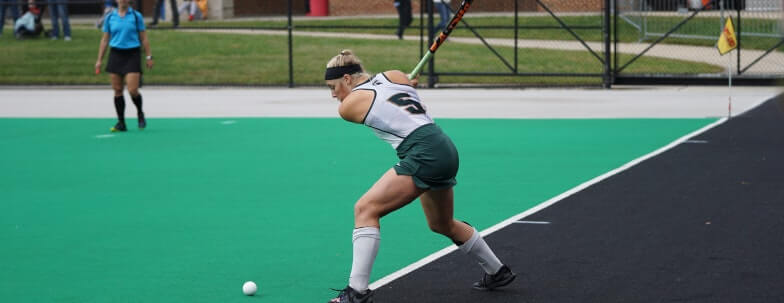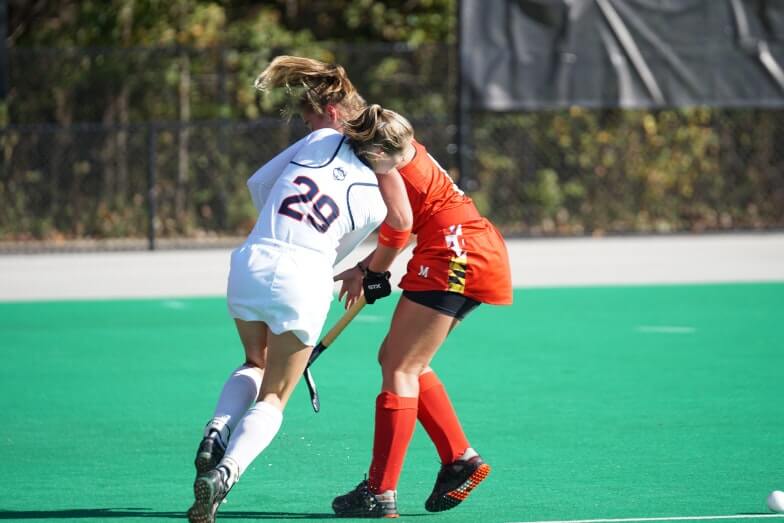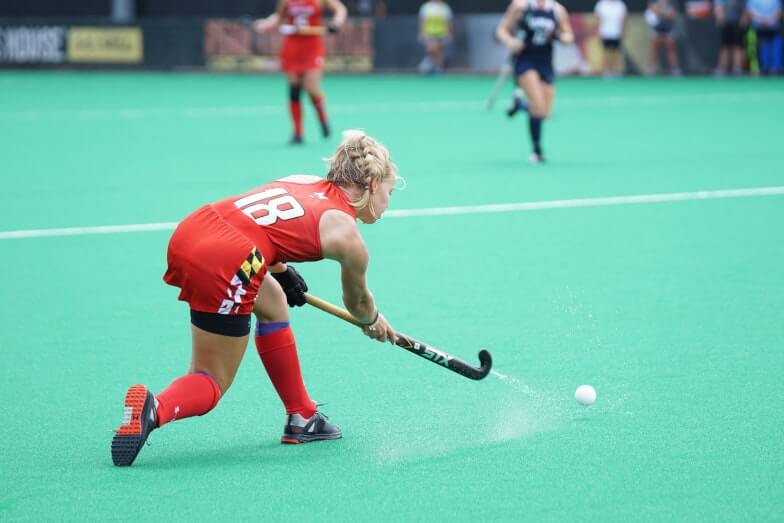What Is a 16-Yard Hit in Field Hockey?

16-Yard Hits
Whether you are playing field hockey or merely watching it, it’s vital to know what it means when the umpire blows for a 16-yard hit. While it may look like just another free hit, it’s not. After all, not all free hits in field hockey are equal. There are various types of free hits in field hockey that are awarded when a player commits a foul, or someone hits the ball out of bounds.
A 16-yard hit is awarded to the defence when a foul is committed inside their striking circle by the opposition or when the ball is hit over the backline by the opposing team. Where most free hits are awarded outside the striking circle, a 16-yard hit is specifically used when incidents occur within the defence’s circle. As the name prescribes, the hit is taken from the 16-yard line.
Understanding the 16-yard hit in field hockey means knowing when and why it is awarded, who plays the ball, and the best technique to employ. The 16-yard hit is an essential move for the defence and can directly affect a game’s outcome.
When Is It a 16-Yard Hit?
While the term used in field hockey is “free hit,” this is not entirely true because someone has to pay the price, and, in this instance, it’s the opposition.
When an umpire blows for a 16-yard hit, they will stretch their arms out to the sides, mirroring an airplane’s wings. This signals to the teams as well as the spectators that a 16-yard hit must be played. The umpire will do this on two occasions.
The first occasion when an umpire will call for a 16-yard hit is when the opposing team commits a foul inside the defence striking circle. Aside from fouls, the second instance when a 16-yard hit will be called is when the ball is hit over the backline by the opposing team (source).
Types of Fouls that Will Earn a 16-Yard Hit
Several fouls can result in a 16-yard hit involving transgressions with the stick, the ball, or by the player. Let’s examine each of these.
Stick Foul
An umpire can call a foul if a player misuses their stick. There are three main instances where this occurs: backsticks, stick obstruction and lifting the stick.
Backsticks
Backsticks refers to when a player uses the rounded side of their hockey stick to strike the ball.
You might be interested to learn more about why field hockey players are not allowed to use both sides of a field hockey stick from our article on this topic.
Stick Obstruction
The umpire will call a foul if a player uses their hockey stick to hit or block another player’s stick. This is known as a stick obstruction.
Lifting Stick
Lastly, if a player lifts their hockey stick too high around other players, the umpire can blow for a foul based on dangerous play.
Ball Foul
In addition to stick fouls, there are also ball fouls that can earn the defence a 16-yard hit. Ball fouls most often come about due to dangerously lifting the ball or kicking the ball, which results in an advantage.
Lifting the Ball
A ball foul will be called if the opposition lifts the ball in the air in a manner considered dangerous. This is known in field hockey as undercutting.
Foot
Often a foul will be blown because the ball hits one of the opposition’s feet. This can be unintentional but is sometimes used as a tactical move made by the defence.
As the attacking team is in their shooting circle, the defence is vulnerable, so they need a way to get the opposition away from their goals. As such, the defence may attempt to push the ball into the opposition’s feet. If the opposition then advantageously kicks the ball, a foul will be called.
This applies to any use of the body by a player who is not the goalkeeper (source).

Image by Jeffrey F Lin via Unsplash
Player Foul
Player fouls are most frequently called when the players cause an obstruction or do something the umpire deems unsafe.
Obstruction
Often players will be fouled for attempting to block their opponents with their bodies. This is known as an obstruction.
Dangerous Play
Dangerous play includes infractions such as pushing other players, tripping other players, taking reckless swings, or intentionally hitting the ball into another player.
Who Takes the 16-Yard Hit?
In the sport of field hockey, each team consists of 11 players, and 4 of those players are called defenders, namely, the goalkeeper, the sweeper, and the two backs (source).
The 16-yard hit is always played by one of the defenders, usually one of the backs. Two backs work alongside the goalie and the sweeper. Their primary role is to defend their goal. Each team has a right-back and a left-back. Depending on the side that the ball went out, either the right or the left-back will take the hit.
Role of the Defenders (Backs)
- Protect their goalie.
- Support the sweeper.
- Stop the opposing teams forwards from being able to obtain scoring positions.
- Clear the ball from the scoring circle.
- Send the ball up the field to the forwards and the midfielders.
Sometimes if the defence’s sweeper had a more powerful hit, then they will be the ones who take the 16-yard hit. Once the umpire has blown the whistle, either the back or the sweeper will fetch the ball and take it out to the 16-yard line.
All of the other players must remain at a distance of five yards from the player with the ball. They are also not allowed to approach the defender who is taking the hit until the ball is in play again (source).
Hockey Techniques for a 16-Yard Hit
If you are the player who is responsible for taking the 16-yard hits, then it’s vital to know the correct techniques. This means knowing how to hit the ball as well as where to hit the ball. A 16-yard hit is a perfect opportunity for the defending team to clear the ball, so it imperative that the player hits the ball as hard and as far as they can.
How to Hit the Ball
When taking the 16-yard hit, you need to think in terms of power and speed, which means employing a hitting technique that will achieve these ends. You want to aim to either drive the ball forward or to slap it forward.
Pushes aren’t commonly used for a 16-yard hit because they are usually not powerful enough to clear the ball away from the striking circle. As a defender, you want to stop the opposing team from intercepting the ball and getting in position for a shot at the goal.
If you want to know more about the types of hitting techniques in field hockey, then be sure to read about what a long hit is.

Image by Jeffrey F Lin via Unsplash
Where to Hit the Ball
When deciding where to hit the ball, you need to look for any gaps in the field where you might be able to slip the ball through. A common technique used by defenders is to clear the ball wide. This means hitting it out to the wings, which is also known as the sideline.
The sidelines are an excellent option because they are often the least congested part of the field. This means that they offer a quick way to get the ball out of the defence’s half.
Sometimes a defender will be hesitant to hit the ball towards the sidelines because they’re worried it will go out of play. However, the defender aims to get the ball as far away from their goal as possible.
As such, it may be a more prudent decision for the defender to attempt to get the ball as far up the field as they can. If the ball does go out of play, then a free hit will be awarded to the opposition. However, at least the ball will be out of the defence’s danger zone.
If the defender can see that one of their teammates is open, they can hit the ball to them. However, there is always a risk that the ball will be intercepted if the defender passes to a teammate who is being guarded by an opponent.
Defenders who take the 16-yard hit need to work on their techniques to ensure they have a powerful drive. They also need to know where to hit and be aware of which of their teammates may be open.
Final Thoughts
The 16-yard hit is the defence’s opportunity to clear the ball and prevent a goal scored against them. As such, it is a critical aspect of the game.
To properly take a 16-yard hit, the defender should put in a great deal of preparation beforehand and then make sure that their hit is powerful enough to push the game back into their opponents half.




